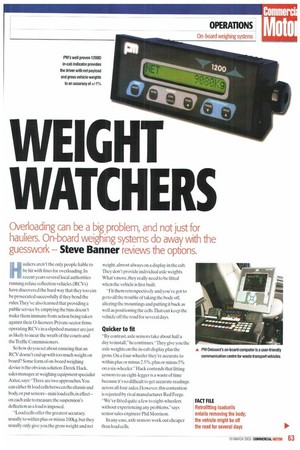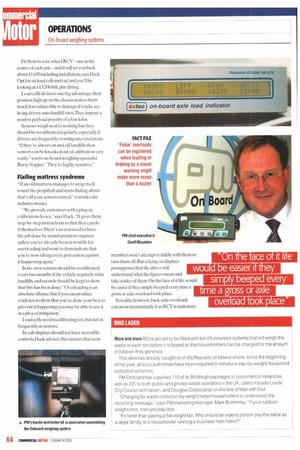WEIGHT WATCHERS
Page 63

Page 64

Page 65

If you've noticed an error in this article please click here to report it so we can fix it.
Overloading can be a big problem, and not just for hauliers. On-board weighing systems do away with the
guesswork — Steve Banner reviews the options.
Hmillers aren't the only people liable to be hit with fines for overloading. In recent years several local authorities running refuse collection vehicles (RCVs) have discovered the hard way that they too can be prosecuted successfully if they bend the rules.They've also learned that providing a public service by emptying the bins doesn't make them immune from action being taken against their 0-licences. Private-sector firms operating RCVs in a slipshod manner are just as likely to incur the wrath of the courts and the Traffic Commissioners.
So how do you set about ensuring that an RCV doesn't end up with too much weight on board? Some form of on-board weighing device is the obvious solution. Derek Hack, sales manager at weighing equipment specialist Axtec, says: -There are two approaches.You can either fit load cells between the chassis and body, or put sensors— mini load cells, in effect — on each axle to measure the suspension's deflection as a load is imposed.
"Load cells offer the greatest accuracy, usually to within plus or minus 100kg, but they usually only give you the gross weight and net weight, almost always on a display in the cab. They don't provide individual axle weights. What's more, they really need lobe fitted when the vehicle is first built.
"nt them retrospectively and you've got to go to all the trouble of taking the body off. altering the mountings and putting it back as well as positioning the cells. That can keep the vehicle off the road for several days.
Quicker to fit
"By contrast, axle sensors take about half a day to install." he continues. "They give you the axle weights on the in-cab display plus the gross. On a four-wheeler they're accurate to within plus or minus 2.5%; plus or minus 5% on a six-wheeler." Hack contends that fitting sensors to an eight-legger is a waste of time because it's so difficult to get accurate readings across all four axles. However, this contention is rejected by rival manufacturer Red Forge. "We've fitted quite a few to eight-wheelers without experiencing any problems," says senior sales engineer Phil Morrison.
In any case, axle sensors work out cheaper than load cells. Fit them to a six-wheel RCV-one in the centre of each axleand it will set you back about £1,650 including installation. says Hack. Opt for six load cells instead and you'll be looking at a L3,500 bill, plus fitting.
Load cells do have one big advantage:their position high up on the chassis makes them much less vulnerable to damage if trucks are being driven onto landfill sites.They impose a modest payload penalty of a few kilos.
Sensors weigh next to nothing but they should be recalibrated regularly, especially if drivers are frequently crossing uneven terrain. If they're always on and off landfills then sensors can be knocked out of calibration very easily," warns on-board weighing specialist Barry Napper."They're highly sensitive."
Flailing mattress syndrome
"If an old mattress manages to wrap itself round the propshaft and starts flailing about that's all your sensors ruined." remarks one industry insider.
-We provide customers with a plug-in calibration device." says Hack."It gives them step-by-step instructions so that they can do it themselves.There's no real need to have the job done by an independent engineer unless you've already been in trouble for overloading and want to demonstrate that you're now taking every precaution against it happening again."
In his view sensors should be recalibrated every two months if the vehicle regularly visits landfills, and records should be kept to show that this has been done:"Overloading is an absolute offence,but if you can produce evidence to show that you've done your best to prevent it happening you may be able to use it in a plea of mitigation."
Load cells need recalibrating too, but not as frequently as sensors.
In-cab displays should not have accessible controls. Hack advises; this ensures that crew members won't attempt to fiddle with them or turn them off. But relying on displays presupposes that the driver will understand what the figures mean and take notice of them. On the face of it life would be easier if they simply beeped every time a gross or axle overload took place.
In reality, however, back-axle overloads can occur momentarily if an RCV is stationary while being loaded with rubbish and pointing uphill.Similarly, front axle overloads can occur for a few seconds if the driver has to hit the brakes hard in an emergency when running down an incline. "You can end up with the display beeping every few minutes," says Hack. "That's going to irritate the driver and crew no end, and they may decide to 'accidentally' put it out of action permanently. In our view it's better for the display to flash a warning instead."
Because temporary overloads can occur, he doesn't recommend disabling the body's packing plate every time it happens: "Do that, and you'll cause crews real difficulties whenever they're trying to empty bins from houses that happen to be on a steep hill. Some local authorities attempt to prevent overloading by reducing the pressure that can be applied to the load by the packing plate. It doesn't always work, however, and can result in rounds not being completed."
Red Forge's Axalert axle sensor package costs from £1,60041,900 on a six-wheeler, rising to £2,400 on an eight-wheeler. This includes litting and calibration.
Red Forge supplies load cells too; it's marketing a system from Welvaarts of the Netherlands that uses load cell technology to produce axle, as well as gross.weight readings. It was exhibited at last year's Chartered Institution ofWastes Management show at Paignton.The display head is programmed with all the vehicle's key parameters the wheelbase for instance so it can make the necessary calculations. Claimed accuracy is ±5%.
The drawback is the price:£10,000 for a sixwheeler."If you look at it in the context of the whole-life cost of the entire vehicle,however, then it's not as expensive as it seems to be at first sight," says Morrison. As well as axle sensors PM Onboard offers a load-cell package called Waste Weigh with a claimed accuracy of at least 1%. Options include a printer. It is about to launch an in-cab display unit, the 1300D, which can be integrated with the vehicle's CAN-bus system; it features a colour touch-screen.
Sensors monitor airbags
Mercedes-Benz offers its Econic RCV with a standard on-board weighing device that uses sensors to monitor the airbags. Air suspension is fitted to all axles. Claimed accuracy is ±2 %, it gives axle weights as well as the gross, and forms part of the chassis' CAN-bus network.
"If it has to be retrofitted to an older Econic chassis with air suspension it costs £275," says a Mercedes spokesman. "What's more, it can be linked to a telematics system so that any overloading can be detected remotely and action taken."
PM Onboard is promoting onboard units that continually monitor the RCV's weight, route plan and load profile.They can be linked with GPS satellite navigation and GPRS data communication packages.
RCV operators would have less reason to worry about overloading if they specified the right body and payload combination to begin with, says Kevin Crowder, UK municipal sales manager at Seddon Atkinson.
"Unfortunately that doesn't always happen," he says. "And if the body and chassis aren't compatible you can guarantee you'll end up with problems."•
CONTACTS
Axtec: www.axtec.co.uk; 01928 581575
Barry Nagger: www.onboardweighing.m.uk; 01427 875574
PM Onboard: www.pmonboard.com;
01274 771177; Red Forge: www.redforge.co.uk; 01527 526112










































































































































































































